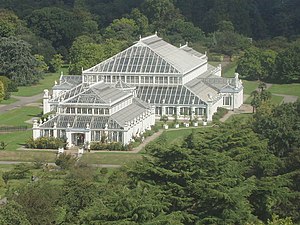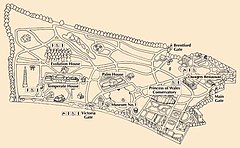world's largest collection of living plants in the London Borough of Richmond upon Thames From Wikipedia, the free encyclopedia
Kew Gardens or the Royal Botanic Gardens, Kew is a UNESCO World Heritage Site in the London Borough of Richmond upon Thames in the United Kingdom.[1]
| Kew Gardens | |
|---|---|
 Kew Gardens Temperate House from the Pagoda | |
 | |
| Type | Botanical |
| Location | London Borough of Richmond upon Thames, England |
| Coordinates | 51°28.480′N 0°17.728′W |
| Area | 121 hectares (300 acres) |
| Opened | 1759 |
| Visitors | more than 1.35 million per year |
| Species | > 30,000 |
| Public transit access | |
| Website | www |
| Official name | Royal Botanic Gardens, Kew |
| Criteria | Cultural: (ii), (iii), (iv) |
| Reference | 1084 |
| Inscription | 2003 (27th Session) |
| Area | 132 ha (330 acres) |
| Buffer zone | 350 ha (860 acres) |
Kew’s historic landscapes and buildings are a collection of gardens and parks and glasshouses.[2]
Kew has the world's largest collection of plant specimens, and is one of the most important centres of research in botany.[2]
Kew Gardens are open to visitors who pay to enter.[3]
Early work on the gardens started in the 17th century when King Henry VII built Richmond Lodge in the area.[4]
The land was a private royal garden until the Victorian era. In 1840, the Royal Botanic Garden was established.[5]
The great expansion of the British Empire in the 19th century brought an expanded interest in exotic plants, so the gardens expanded.[6]
In the 20th century, the gardens continued to grow larger and even more important in plant science.[7]
The gardens were named a UNESCO World Heritage Site in 2003.[1]
The Temperate glass house was fixed over 5 years. It opened again in 2018.[8]
Seamless Wikipedia browsing. On steroids.
Every time you click a link to Wikipedia, Wiktionary or Wikiquote in your browser's search results, it will show the modern Wikiwand interface.
Wikiwand extension is a five stars, simple, with minimum permission required to keep your browsing private, safe and transparent.